Im Schutze der Burg / A Castle for all Seasons
Authors: Inka & Markus Brand
Publisher: Eggertspiele - Hutter Trade / Rio Grande Games
Year: 2008
review by

| x |
|
|
|
|
|
|
|
|
|
|
|
|
|
|
|
|
|
|
|
|
|
|
|
|
|
|
|
|
|
|
|
|
|
|
|
|
|
|
|
|
|
|
|
|
|
|
|
|
|
|
|
|
|
|
|
|
|
|
 |
The choice for the location of a castle is not a difficult one: high on the rocks. After this, the building plans for the various lodgings are quite easily made. Which of the buildings are going to be built is on to the two to four players, who receive points or money for each completed building. They also take care that the required building materials arrive at the spot and that financial ways and means do not run dry. On payment an apprentice can be placed at the larger buildings when completed; they score a various amount of points at the end of the game. |
|
|
|
|
|
|
|
|
|
|
|
|
|
| x |
|
|
|
|
|
|
|
|
|
|
|
|
|
|
|
|
|
|
|
|
|
|
|
|
|
|
|
|
|
|
|
|
|
|
|
|
|
|
|
|
|
|
|
|
|
|
|
|
|
|
|
|
|
|
|
|
|
|
| The supply of materials, the manpower and the money are all triggered by eight role cards of which one each round is played and placed in front of a player. All players simultaneously choose a role from the cards in their hand. One role, the master builder, can be used to take all played cards back in a player’s hand after which a player has a full choice of roles in the next round. |
|
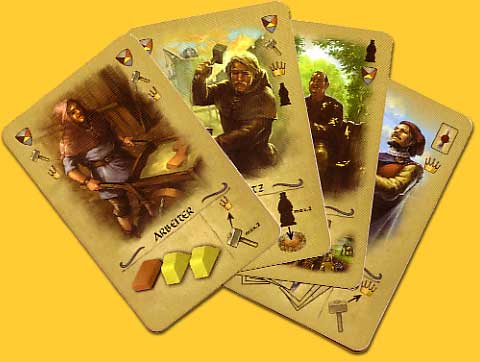 |
|
|
|
|
|
|
|
| x |
|
|
|
|
|
|
|
|
|
|
|
|
|
|
|
|
|
|
|
|
|
|
|
|
|
|
|
|
|
|
|
|
|
|
|
|
|
|
|
|
|
|
|
|
|
|
|
|
|
|
|
|
|
|
|
|
|
|
 |
|
This master builder by the way is a peculiar lad, a kind of smart guy who takes use of other peoples efforts, probably to try to curry favor with the knight of the castle by using slander and gossip: when one or more players have played the bricklayer, stonemason or one of the workers, ànd that player has built something with that role, the player who played the master builder that round scores five free and gratis points for each of those buildings. Thank you very much! |
|
|
|
|
|
|
|
|
|
| x |
|
|
|
|
|
|
|
|
|
|
|
|
|
|
|
|
|
|
|
|
|
|
|
|
|
|
|
|
|
|
|
|
|
|
|
|
|
|
|
|
|
|
|
|
|
|
|
|
|
|
|
|
|
|
|
|
|
|
| The trader, bricklayer and workers supply a player with the building materials; each of the worker cards shows a different mix of three materials of which one can be taken by up to two other players who played the stonemason; the hurt player gets one money as salve on the wound. |
|
 |
| x |
|
|
|
|
|
|
|
|
|
|
|
|
|
|
|
|
|
|
|
|
|
|
|
|
|
|
|
|
|
|
|
|
|
|
|
|
|
|
|
|
|
|
|
|
|
|
|
|
|
|
|
|
|
|
|
|
|
|
|
|
|
Now we turn to some medieval economy: the materials have different values. Sand represents 1 building point, wood 2, clay 4 en stone 5 building points. The building boards show their value in building points. A player can combine any material but he must match the proper and exact value in building points ànd he must use at least three different materials! And it is here that a player needs time to get the right combination, because all of the buildings have an even amount of building points: 8, 10, 14, to a maximum of 30. The score for a building rises with their size, but building more of the smaller buildings score slightly better. |
|
| x |
|
|
|
|
|
|
|
|
|
|
|
|
|
|
|
|
|
|
|
|
|
|
|
|
|
|
|
|
|
|
|
|
|
|
|
|
|
|
|
|
|
|
|
|
|
|
|
|
|
|
|
|
|
|
|
|
|
|
| Is a player able to build that often, or as often as he would like? Well, no. A game stretches over twelve or fifteen rounds, depending on the number of players, and the bricklayer, the most favorable role as he can build for the full amount of points is, when played, not available until the masterbuilder calls back all roles. And with eight roles, a game with twelve rounds is not very much. Further, playing the masterbuilder feels as a lost turn, unless a player has the right gut feeling and played this role in a round where one or more players are building and the master builder can score freely. |
|
 |
| x |
|
|
|
|
|
|
|
|
|
|
|
|
|
|
|
|
|
|
|
|
|
|
|
|
|
|
|
|
|
|
|
|
|
|
|
|
|
|
|
|
|
|
|
|
|
|
|
|
|
|
|
|
|
|
|
|
|
|
 |
|
A player also needs enough money in cash to place his helpers, a not to be underestimated part because these take care of the essential bonus points, so from time to time the messenger also has to be called in. |
|
|
|
|
|
|
|
|
|
|
|
|
|
|
|
|
|
|
|
|
|
|
|
|
|
|
|
|
|
|
|
|
|
|
| x |
|
|
|
|
|
|
|
|
|
|
|
|
|
|
|
|
|
|
|
|
|
|
|
|
|
|
|
|
|
|
|
|
|
|
|
|
|
|
|
|
|
|
|
|
|
|
|
|
|
|
|
|
|
|
|
|
|
|
| And if a player could build as often as he likes, does he have enough of the required materials at his disposal then? By playing a worker a player only could get three materials - provided that the stonemason does not take away any material and leave him with even less resources. The bricklayer could be more profitable then: each time a player has played the trader, one or more materials are placed at the defense tower - the bricklayer may take all materials of one kind that are placed at the tower; for instance three stone that are worth fifteen building points, a nice fondament for a building or two! |
|
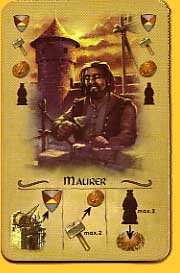 |
|
 |
| x |
|
|
|
|
|
|
|
|
|
|
|
|
|
|
|
|
|
|
|
|
|
|
|
|
|
|
|
|
|
|
|
|
|
|
|
|
|
|
|
|
|
|
|
|
|
|
|
|
|
|
|
|
|
|
|
|
|
|
 |
|
Or a player could play the trader that enables him to put a helper at one of the wished material piles; the position must be free but if all positions are taken a player may send away an opponents helper and place one of his own instead. Subsequently all players with a helper at these supply stacks may take materials but have to discard one and place it at the defence tower: take four sand, place one of it at the tower, take two stone, hand in one at the tower; it is, we hope, clear for the rest of the resources? |
|
|
|
|
|
|
|
|
|
|
|
|
|
|
|
|
|
|
|
|
|
|
|
|
|
|
|
|
|
| x |
|
|
|
|
|
|
|
|
|
|
|
|
|
|
|
|
|
|
|
|
|
|
|
|
|
|
|
|
|
|
|
|
|
|
|
|
|
|
|
|
|
|
|
|
|
|
|
|
|
|
|
|
|
|
|
|
|
|
| We only can retail our apprentices until a large building has been built; a tower or house only gives points or money and cannot accomodate helpers. The copper coloured fields near the building show how much money it requires to place an apprentice there; what kind of bonus a building gives is done in understandable icons. |
|
 |
|
|
|
|
|
|
|
|
|
|
|
|
|
|
|
|
|
|
|
|
|
|
|
|
|
|
|
|
|
|
|
|
|
|
|
|
|
|
|
|
|
|
|
|
|
|
|
|
|
|
|
|
|
|
|
|
|
|
|
|
|
 |
|
Scoring for erected buildings is done immediately; the end bonus is handled per building . Some buildings have room for more than one apprentice, but the first to come can occupy the cheaper spot, or it gives double points. One building scores for each not built building, where the other scores the opposite: each non built building. At other buildings money or silver can be exchanged for points, or a maximum of five materials exchanged from building points to 'real' points. Take your pick! |
|
|
|
|
|
|
|
|
|
|
|
|
|
|
|
|
|
|
|
|
|
|
| x |
|
|
|
|
|
|
|
|
|
|
|
|
|
|
|
|
|
|
|
|
|
|
|
|
|
|
|
|
|
|
|
|
|
|
|
|
|
|
|
|
|
|
|
|
|
|
|
|
|
|
|
|
|
|
|
|
|
|
| x |
|
|
|
|
|
|
|
|
|
|
|
|
|
|
|
|
|
|
|
|
|
|
|
|
|
|
|
|
|
|
|
|
|
|
|
|
|
|
|
|
|
|
|
|
|
|
|
|
|
|
|
|
|
|
|
|
|
|
| x |
|
|
|
|
|
|
|
|
|
|
|
|
|
|
|
|
|
|
|
|
|
|
|
|
|
|
|
|
|
|
|
|
|
|
|
|
|
|
|
|
|
|
|
|
|
|
|
|
|
|
|
|
|
|
|
|
|
|
 |
|
|
|
|
|
|
|
|
|
|
|
|
|
|
|
|
|
|
|
|
|
|
|
|
|
|
|
|
|
|
|
|
|
|
|
|
|
|
|
|
|
|
|
|
|
|
|
|
|
|
|
|
|
|
'Im Schutze der Burg' / 'A castle for all seasons' looks really beautiful and this is due to Michael Menzel who once again has done his utmost. The efficacious warmyellow atmosphere we already encountered in 'Stone Age' has been kept here too. Michael is a master in applying light: the card of the trader illustrates this nicely: it is high summer, we walk in the woods, and we see the sun shining through the trees, causing all kind of little light spots on every object it hits. It is this love for detail, and the ability to give each face - wether the basis is a photo of a friend, acquintance, or stock material - its own character, and this shows the strength of Menzel as an illustrator: look at the trader's face and you see the simple but satisfied life he lives - with apologies to the person Michael took as a model!
Also, the production of the game leaves nothing to be desired. |
|
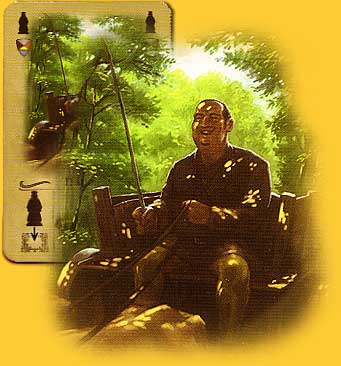 |
|
|
|
|
|
|
|
|
| x |
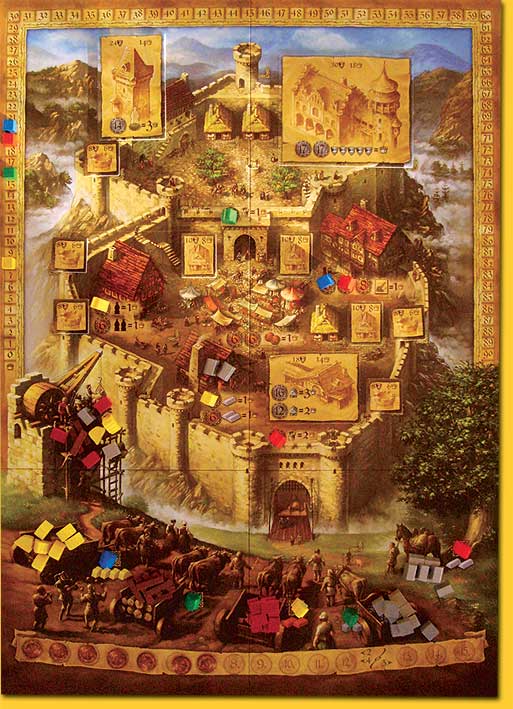 |
A game rarely lasts longer than an hour; the rounds succeed quickly but a player occasionally has to calculate what and how many of his materials he can or has to use when he wants to build, and this can take a bit because of the requirements in match and diversity. |
|
|
|
|
|
|
|
|
|
|
| x |
|
|
|
|
|
|
|
|
|
|
|
|
|
|
|
|
|
|
|
|
|
|
|
|
|
|
|
|
|
|
|
|
|
|
|
|
|
|
|
|
|
|
|
|
|
|
|
|
|
|
|
|
|
|
|
|
|
|
| Because of the limited amount of rounds, and the combination of played cards with an other player's cards - such as playing the worker whilst an other player has played a stonemason, or playing a bricklayer and an other player played his master builder that round - picking a role or the effect of it rather is a random event. The presence of a winter board which bring four of six event cards into play has no real added value and could as well have been incorporated in the 'standard' game. |
|
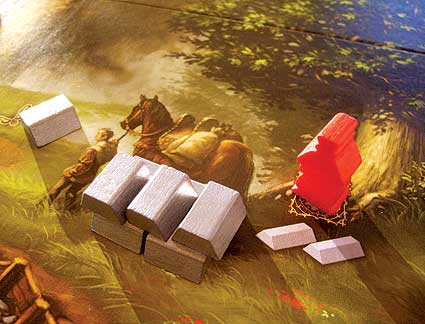 |
|
|
|
|
|
|
|
|
| x |
|
|
|
|
|
|
|
|
|
|
|
|
|
|
|
|
|
|
|
|
|
|
|
|
|
|
|
|
|
|
|
|
|
|
|
|
|
|
|
|
|
|
|
|
|
|
|
|
|
|
|
|
|
|
|
|
|
|
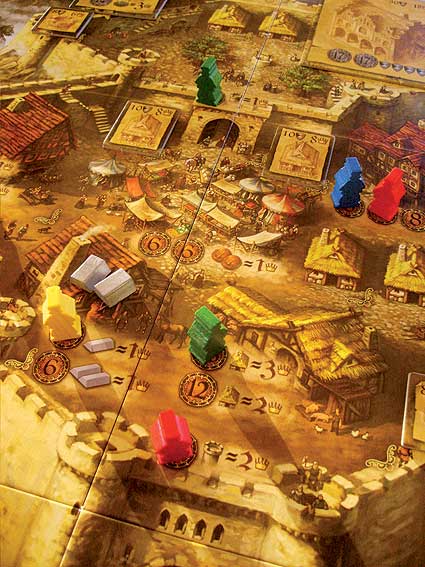 |
|
It is with some hesitation to bring it up, but 'Im Schutze der Burg' / 'A castle for all seasons' is like a beautiful packed praline in which all kinds of delicate ingredients have been put. All exudes 'delicious', your eyes already have fallen for the first temptation but somehow your papillae each time give a different sign. Finally, after repeatedly and thoughtful tasting, disappointed you must come to this conclusion: every ingredient that it needs is present, but this recipe has not led to the wanted delicate result. Choosing roles, placing tokens, collecting materials, building, it all is too random; a player has not enough time and direction - which bonus to go for is every player's wild guess - to act or react tactically.
The one thing 'Im Schutze der Burg' / 'A Castle for all Seasons' has perfectly succeeded in, is to show how good 'Puerto Rico' and 'Die Säulen der Erde / Pillows of the Earth' really are...
© 2009 Richard van Vugt |
|
|
|
|
|
|
|
|
| x |
|
|
|
|
|
|
|
|
|
|
|
|
|
|
|
|
|
|
|
|
|
|
|
|
|
|
|
|
|
|
|
|
|
|
|
|
|
|
|
|
|
|
|
|
|
|
|
|
|
|
|
|
|
|
|
|
|
|
Im Schutze der Burg / A Castle for all Seasons, Inka & Markus Brand, Eggertspiele-Hutter Trade / Rio Grande Games, 2008 - 2 to 4 players, 10 years and up, 45 - 60 minutes
|
|
|
|
|
|
|
|
|
  |
|
|
|
|
|
|
|
|
|
|
|
|
|
|
|
|
|
|
|
|
|
|
|
|
|
|
|
|
|
|
|
|
|
|
|
|
|
|
|
|
|
|
|
|
|
|
|
|
|
|
|
|
|
|
  |
Nothing new under the sun |
|
|
|
|
|
|
|
|
|
|
|
|
|
|
|
|
|
|
|
|
|
|
|
|
|
|
|
|
|
|
|
|
|
|
  |
Familiar elements made a new and surprisingly original game |
|
|
|
|
|
|
|
|
|
|
|
|
|
|
  |
|
|
|
|
|
|
|
|
|
|
|
|
|
|
|
|
|
|
|
|
|
|
|
|
|
|
|
|
|
|
|
|
|
|
|
|
|
|
|
|
|
|
|
|
|
|
|
|
|
|
|
|
|
|
  |
Yet different than 'Cuba' and 'Pillars of the Earth' |
|
|
|
|
|
|
|
|
|
|
|
|
|
|
  |
|
|
|
|
|
|
|
|
|
|
|
|
|
|
|
|
|
|
|
|
|
|
|
|
|
|
|
|
|
|
|
|
|
|
|
|
|
|
|
|
|
|
|
|
|
|
|
|
|
|
|
|
|
|
  |
|
|
|
|
|
|
|
|
|
|
| x |
|
|
|
|
|
|
|
|
|
|
|
|
|
|
|
|
|
|
|
|
|
|
|
|
|
|
|
|
|
|
|
|
|
|
|
|
|
|
|
|
|
|
|
|
|
|
|
|
|
|
|
|
|
|
|
|
|
|
| x |
|
|
|
|
|
|
|
|
|
|
|
|
|
|
|
|
|
|
|
|
|
|
|
|
|
|
|
|
|
|
|
|
|
|
|
|
|
|
|
|
|
|
|
|
|
|
|
|
|
|
|
|
|
|
|
|
|
|
 |
|
|
|
|
|
|
|
|
|
|
|
|
|
|
|
|
|
|
|
|
|
|
|
|
|
|
|
|
|
|
|
|
|
|
|
|
|
|
|
|
|
|
|
|
|
|
|
|
|
|
|
|
|
|
 |
|
|
|
|
|
|
|
|
|
|
|
|
|
|
|
|
|
|
|
|
|
|
|
|
|
|
|
|
|
|
|
|
|
|
|
|
|
|
|
|
|
|
|
|
|
|
|
|
|
|
|
|
|
|
| x |
|
|
|
|
|
|
|
|
|
|
|
|
|
|
|
|
|
|
|
|
|
|
|
|
|
|
|
|
|
|
|
|
|
|
|
|
|
|
|
|
|
|
|
|
|
|
|
|
|
|
|
|
|
|
|
|
|
|
 |
|
|
|
|
|
|
|
|
|
|
|
|
|
|
|
|
|
|
|
|
|
|
|
|
|
|
|
|
|
|
|
|
|
|
|
|
|
|
|
|
|
|
|
|
|
|
 |
|
|
|
|
|
|
|
|
|
|
|
|
|
|
|
|
|
|
|
|
|
|
|
|
|
|
|
|
|
|
|
|
|
|
|
|
|
|
|
|
|
|
|
|
|
|